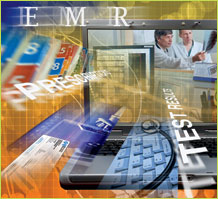Learn why health information technology means safer, better care for you and your family.
Before electronic medical records were available, David Gorelick, M.D. made his own.
After medical school, he served as a doctor in the military during the Gulf War, and learned to use computers on a Navy ship. He applied that knowledge when he started his internal medicine residency in 1991. "I made a database so I could track patients' medical histories, allergies, reminders to myself," Dr. Gorelick says. "It helped me keep track of labs and tests I was ordering, so I could make sure that patients actually had the tests, and what the results were. It was much more efficient than paper records."
But as useful as Dr. Gorelick's system was, he still had to use paper charts as well. All that changed in 2005, when his group, Aquidneck Medical Associates, became one of the first practices in Rhode Island to implement electronic medical records (EMRs) through the Quality Counts Program. (See "Investing in better health" on right.) EMRs are computerized medical files that store patients' information, including medical histories, treatments, prescriptions, test results, and more.
And Dr. Gorelick is very pleased with the results: "I can see many patients with complex problems, find information within seconds, document progress notes, order labs, transmit prescriptions electronically, and review documents and telephone messages more efficiently than would ever be possible with paper charts."
His EMR system also includes an "outstanding orders" feature that identifies tests that have been ordered but not yet performed. He says, "Several malignancies were discovered as a result of rescheduling overdue tests that were recognized through outstanding orders. Without this feature, some of these cancers may not have been discovered in time to provide a cure."
The way ahead
EMRs have received a lot of attention in recent months, thanks to the American Recovery and Reinvestment Act of 2009. This federal economic stimulus program allotted $19 billion in funding and incentives to encourage doctors and hospitals to purchase and use EMRs. Here's a quick look at how this new technology can help improve healthcare:
- Reduced medication errors. With EMRs, doctors can keep a list of a patient's medications—from prescriptions to over-the-counter drugs to supplements—in one secure location. And EMRs can alert physicians to any potential drug interactions or allergic reactions. Doctors can also e-prescribe by sending prescriptions directly to a pharmacy using an EMR. Dr. Gorelick, who was recently named one of the top e-prescribers in the country, says e-prescribing helps cut down on medical errors due to handwriting.
- Improved quality of care. EMRs remind doctors about important tests and screenings a patient needs, such as a routine mammogram or a hemoglobin A1c test for a person with diabetes. Use of EMRs has even been linked to fewer deaths during hospitalizations. A January 2009 study in the Archives of Internal Medicine reported a significant reduction in patient deaths in hospitals where electronic records are used. The study also found that the more health information technology the hospital used, the greater the reduction was in patient deaths.
- Lowered costs. According to the New England Journal of Medicine, the cost of purchasing, installing, and implementing an EMR system is estimated to be $40,000. However, over the long term, EMRs save money for physicians, patients, and the healthcare system as a whole through fewer duplicate tests, improved efficiency, improved quality of care, reduced administration time, and more. A RAND study estimates the savings will be $80 billion per year when 90 percent of doctors are using EMRs.
Currently, the rates of EMR adoption are fairly low for small practices (ranging from 9 to 30 percent), with significantly higher rates for large practices and hospitals (ranging from 50 to 68 percent). However, even before the stimulus funding was announced, a New England Journal of Medicine survey found that 26 percent of doctors without EMR systems planned on buying one within the next two years.
The information exchange
Right now, the information that Dr. Gorelick puts into his EMR can only be accessed by the other doctors in his practice. It doesn't connect to the specialists his patients visit, or the labs where they get their tests. If one of his patients has a medical emergency, the valuable patient information in his EMR is not readily available to emergency room doctors. But soon, that will change.
Rhode Island is one of a handful of states around the country—others include Massachusetts and California—developing a health information exchange (HIE). This means that, with a patient's permission, doctors' offices, pharmacies, labs, and other healthcare providers across the state will be able to access each other's medical information when it's needed to provide care. So if you go to a specialist, he or she will be able to access all your up-to-date medical records, and see results of any tests and screenings you've already had. And if you were in an accident or situation where you were unable to provide medical information, the hospital would be able to locate it quickly through the HIE. This will help ensure that you receive the best possible care.
Dr. Gorelick is on the Clinical IT Leadership Committee of the Rhode Island Quality Institute, the organization leading the development of Rhode Island's HIE, called currentcare. He says, "Interconnectivity through currentcare will be invaluable to patients, as any of their physicians at any location will have secure access to their health information."
To give healthcare providers access to important health information through currentcare, Rhode Islanders should sign up at currentcareri.com. People outside of Rhode Island should contact their local Department of Health to ask about an HIE.





